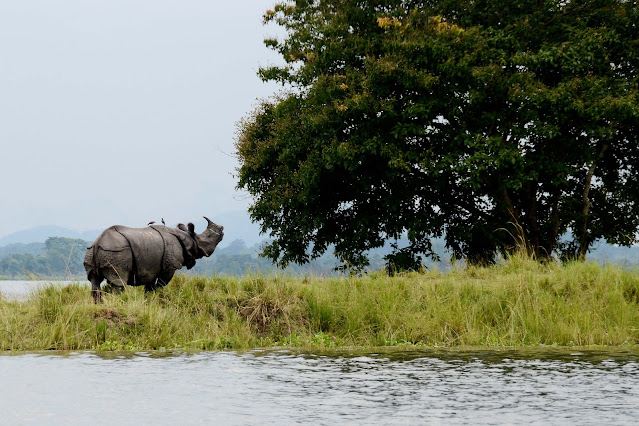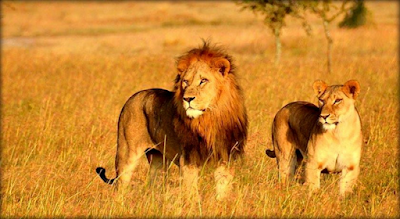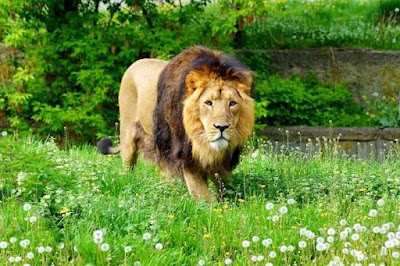Introduction :
Embarking on a Wildlife Tour in India is like entering a realm where nature's magnificence unfolds in a stunning display of biodiversity. Jim Corbett National Park, among the many destinations that attract wildlife enthusiasts, serves as a testament to India's dedication to conservation. Situated in the foothills of the Himalayas, Corbett is not only the oldest national park in the country but also a sanctuary for the majestic Bengal tiger. As the golden sunlight filters through the dense foliage, revealing the intricate play of shadows, visitors can embark on an exhilarating safari, traversing the park's diverse landscapes of dense forests and winding rivers. Corbett's abundant flora and fauna go beyond the iconic tigers, offering glimpses of leopards, elephants, and a vibrant variety of birdlife. The park's enchanting atmosphere is enhanced by the sounds of nature, creating an immersive experience that remains in the memories of those fortunate enough to witness it.
Heading west to the arid landscapes of Rajasthan, Ranthambore National Park seamlessly combines history and wildlife. Home to the historic Ranthambore Fort, this park is a treasure trove for those seeking encounters with the elusive Bengal tigers amidst ancient architecture. The park's rugged terrain is adorned with lush greenery and tranquil lakes, providing a picturesque backdrop for a safari adventure. Ranthambore's tigers, often seen lounging in the shade of ancient ruins or stealthily prowling through the undergrowth, exemplify the delicate balance between the historical past and the untamed present. As visitors explore the park's winding trails, they witness not only the raw beauty of nature but also the coexistence of wildlife and cultural heritage. Ranthambore offers a unique narrative, where the tales of the past and the mysteries of the wild intertwine, creating an unforgettable chapter in the journey of any wildlife enthusiast exploring India's diverse landscapes.
Ranthambore National Park, Rajasthan
Arranged in Sawai Madhopur locale in Indian province of Rajasthan, Ranthambhore Tiger Reserve is one of the biggest and renowned public parks in northern India. It is universally popular with enormous populace of exceptionally imperiled regal Bengal tigers. It is home to an assortment of warm blooded creatures, birds, reptiles, trees and plants. Jeep safaris are coordinated here to investigate the wilderness of Ranthambhore, best case scenario. You will have very lively experience of wilderness the travel industry by investigate the attractions of Ranthambhore untamed life safe-haven in Rajasthan.
Ranthambore National Park, situated in the Sawai Madhopur district of the Indian state of Rajasthan, stands as a testament to the rich biodiversity and natural beauty that northern India has to offer. Renowned for being one of the largest and most celebrated national parks in the region, Ranthambore is an iconic sanctuary that has garnered international acclaim, particularly for its substantial population of the highly endangered Royal Bengal tigers.
Spanning across acres of diverse landscapes, Ranthambore Tiger Reserve is not merely a haven for the regal Bengal tigers; it is a thriving ecosystem that houses a myriad of mammals, birds, reptiles, and a lush variety of flora. The park's unique blend of biodiversity and its commitment to wildlife conservation have made it a premier destination for nature enthusiasts and wildlife aficionados.
The heart of Ranthambore lies in its magnificent inhabitants, particularly the regal Bengal tigers that roam freely within its boundaries. These majestic creatures, highly endangered in the wild, find sanctuary in Ranthambore, where efforts are continuously made to protect and preserve their dwindling numbers. The opportunity to witness these awe-inspiring big cats in their natural habitat is an experience that draws wildlife enthusiasts from around the globe.
In addition to the tigers, Ranthambore boasts a diverse array of wildlife, including leopards, sloth bears, sambar deer, and crocodiles. The park's rich biodiversity extends to the avian residents as well, with over 270 species of birds gracing the skies and trees of Ranthambore. The cacophony of bird calls, the sight of elegant deer grazing, and the elusive presence of predators create an immersive experience for visitors seeking a genuine encounter with the wild.
To fully appreciate the wonders of Ranthambore National Park, visitors can embark on thrilling jeep safaris that traverse the varied terrain of the reserve. These safaris offer a unique opportunity to explore the nooks and crannies of the jungle, providing an up-close encounter with the diverse flora and fauna that call Ranthambore home. Knowledgeable guides accompany the safaris, sharing insights into the behaviors and habitats of the park's inhabitants.
The Ranthambore jeep safaris are a sensory delight, immersing visitors in the sights and sounds of the untamed wilderness. From the rustling leaves to the distant calls of birds, every moment in the park is a testament to the untouched beauty of nature. The unpredictable nature of wildlife encounters adds an element of excitement, making each safari a distinct and unforgettable adventure.
Ranthambore National Park is not only a sanctuary for wildlife but also a stronghold for conservation efforts. The park actively engages in initiatives aimed at preserving the delicate balance of its ecosystem. Conservationists and wildlife experts collaborate to implement strategies for the protection of endangered species, ensuring the sustainability of Ranthambore's biodiversity for future generations.
Efforts to mitigate human-wildlife conflict, anti-poaching patrols, and community involvement in conservation projects are integral components of Ranthambore's commitment to environmental stewardship. The park serves as a model for responsible wildlife tourism, emphasizing the importance of coexistence between humans and the natural world.
Beyond its natural wonders, Ranthambore is situated in the culturally rich state of Rajasthan, adding a vibrant tapestry of traditions and history to the visitor's experience. The park's proximity to the historic Ranthambore Fort further enhances the cultural significance of the region. Dating back to the 10th century, the fort stands as a testament to Rajasthan's architectural prowess and historical heritage.
Visitors to Ranthambore have the opportunity to delve into the cultural richness of Rajasthan, exploring the intricate architecture of the fort, witnessing traditional folk performances, and savoring the delectable cuisine of the region. The seamless integration of nature and culture makes Ranthambore a holistic destination, catering to the diverse interests of those seeking a multifaceted travel experience.
As the allure of Ranthambore continues to captivate travelers, there is a growing emphasis on responsible tourism within the park. Sustainable practices, eco-friendly accommodations, and educational programs contribute to the preservation of Ranthambore's ecological integrity. Visitors are encouraged to adhere to ethical guidelines during their stay, promoting a harmonious coexistence between human visitors and the resident wildlife.
Kaziranga National Park, Assam
Nestled in the verdant landscapes of the Indian province of Assam, Kaziranga National Park stands as an iconic haven for wildlife enthusiasts and ecotourists alike. Renowned for its rich biodiversity and unique ecosystems, this national park is a testament to the magnificence of nature and the importance of conservation efforts. Home to a thriving population of majestic Bengal tigers, one-horned rhinoceroses, wild water buffaloes, swamp deer, and an array of avian species, Kaziranga is a sanctuary that captivates the hearts of all who venture into its lush wilderness. The park also offers the exhilarating experience of elephant safaris, providing an unparalleled opportunity to explore the depths of the Kaziranga wildlife sanctuary.
Kaziranga National Park, declared a UNESCO World Heritage Site in 1985, is situated in the northeastern part of India, within the folds of Assam's embrace. Spanning an extensive area, the park serves as a vital stronghold for the conservation of endangered species and the preservation of fragile ecosystems. Its diverse topography, comprising grasslands, wetlands, and dense forests, creates a mosaic of habitats that sustains a remarkable variety of flora and fauna.
Undoubtedly, one of the most enchanting features of Kaziranga is its population of regal Bengal tigers. Revered for their awe-inspiring beauty and strength, these tigers roam freely in their natural habitat, contributing to the park's allure. The park's commitment to their protection and conservation ensures that visitors can witness these magnificent creatures in all their glory, embodying the wild spirit of Kaziranga.
A symbol of prehistoric times and a testament to the park's successful conservation initiatives, the one-horned rhinoceros is another star attraction at Kaziranga. The park boasts a significant population of these magnificent creatures, providing a rare opportunity for wildlife enthusiasts to witness their grace and grandeur. The one-horned rhinoceros, with its imposing presence, exemplifies the resilience and adaptability of species when provided with a conducive environment for survival.
Wild water buffaloes, an integral part of Kaziranga's ecosystem, also thrive within the park's boundaries. These massive creatures can be spotted grazing peacefully in the grasslands or bathing in the park's water bodies, creating a harmonious tableau of wildlife coexisting in their natural habitat. As with other species within Kaziranga, the conservation efforts directed towards wild water buffaloes underscore the park's commitment to maintaining the delicate balance of its ecological tapestry.
In addition to these charismatic megafauna, Kaziranga is a paradise for bird enthusiasts. The park is home to a diverse avian population, with over 500 species of birds recorded within its precincts. From majestic eagles soaring high in the sky to vibrant waterfowl gracefully navigating the wetlands, Kaziranga offers a bird-watching experience like no other. The sheer variety of species, both resident and migratory, makes it a haven for ornithologists and nature lovers seeking to immerse themselves in the melodious symphony of the avian world.
To enhance the visitor experience and facilitate a deeper connection with the wilderness, Kaziranga National Park organizes elephant safaris. These safaris provide a unique vantage point, allowing visitors to traverse the rugged terrain and dense foliage while accompanied by trained mahouts and their gentle giants. The experience of encountering wildlife from the back of an elephant is unparalleled, offering a sense of immersion in the untamed beauty of Kaziranga.
Beyond its role as a wildlife sanctuary, Kaziranga also plays a crucial role in biodiversity conservation. The park's management employs various strategies to protect and preserve its ecosystems, including anti-poaching measures, habitat restoration initiatives, and community engagement programs. The symbiotic relationship between the park and the surrounding communities underscores the importance of harmonizing conservation efforts with the needs of local residents.
Corbett National Park, Uttarakhand
Gir National Park, Gujarat
Nestled in the vibrant Indian state of Gujarat, Gir National Park, also known as Sasan Gir Forest Park and Wildlife Sanctuary, emerges as a prime wildlife destination that beckons nature enthusiasts and wildlife aficionados alike. This sanctuary holds the distinction of being home to a significant population of the Asiatic lion, making it a sanctuary of unparalleled importance. As the sole habitat of the purebred Asiatic lions, Gir National Park is a testament to India's commitment to wildlife conservation and preservation of endangered species. With a rich tapestry of biodiversity, encompassing various mammals, birds, reptiles, and insects, a visit to Gir promises an immersive experience with the wonders of the wild.
The Realm of the Asiatic Lions: Gir National Park stands as a bastion for the majestic Asiatic lion, housing a substantial population of these iconic big cats. The park's landscape, a harmonious blend of deciduous forests, scrublands, and grassy plains, provides an ideal habitat for the Asiatic lions to roam freely. Observing the lions in their natural habitat, engaged in their regal activities, is an awe-inspiring spectacle that captivates the hearts of those fortunate enough to embark on a Gir lion tour.
Diverse Fauna: The allure of Gir extends beyond its famed lions to a diverse array of fauna that populates its varied ecosystems. With approximately 38 different species of mammals, the park showcases the coexistence of various wildlife, including leopards, spotted deer, sambar deer, langurs, and wild boars. The avian population is equally captivating, with over 300 species of birds gracing the skies, making it a haven for birdwatchers. From the striking plumage of the Indian Pitta to the elegant flight of the Crested Serpent Eagle, Gir resonates with the melodies and movements of a myriad of bird species.
Reptiles and Insects: Gir National Park is also home to a diverse reptilian and insect population, adding to its ecological richness. Explorers may encounter 37 different species of reptiles, including crocodiles, snakes, and lizards, contributing to the intricate web of life within the park. The insect world in Gir is equally fascinating, with over 2000 different species of insects contributing to the park's intricate and delicate ecosystem.
Gir Lion Tour: Embarking on a Gir lion tour is a journey into the heart of the wilderness, providing a rare opportunity to witness the behaviors and interactions of the king of the jungle. The park organizes safari experiences that allow visitors to traverse its landscapes and observe the majestic lions, along with the myriad of other wildlife that calls Gir home. Knowledgeable guides accompany these safaris, offering insights into the park's ecology, the behavior of its inhabitants, and the conservation efforts in place to protect these endangered species.
Conservation Efforts and Success: Gir National Park has played a pivotal role in the conservation of the Asiatic lion, contributing significantly to the species' survival. Conservation efforts include habitat preservation, anti-poaching measures, and community engagement to foster harmony between the local populace and the wildlife. The success story of Gir's conservation efforts stands as a beacon for similar initiatives globally, showcasing the positive impact of dedicated wildlife preservation.
Beyond the Lions: While the Asiatic lions rightfully claim the spotlight, Gir National Park is a microcosm of biodiversity that extends beyond these iconic predators. The park's ecosystem is a delicate balance of flora and fauna, with teak forests, acacia trees, and floral varieties creating a scenic backdrop for the wildlife spectacle. The Kamleshwar Dam within the park adds a touch of serenity, providing a watering hole for various species and an excellent spot for birdwatching.
Cultural and Natural Harmony: Gir National Park is not merely a sanctuary for wildlife; it is also a testament to the cultural and natural harmony that defines the region. The Maldharis, the traditional pastoral communities residing in the periphery of the park, coexist with the wildlife in a symbiotic relationship. This cultural tapestry enhances the overall experience of visitors, offering a glimpse into the seamless interweaving of human life with the untamed wilderness.
Periyar National Park, Kerala
Nestled within the verdant landscapes of the Indian state of Kerala, the Periyar Wildlife Sanctuary stands as a beacon of biodiversity and a prime destination for wildlife enthusiasts and tourists alike. Renowned for its captivating scenery and diverse flora and fauna, this sanctuary has become a cherished gem of Kerala's wildlife tourism. Embarking on a serene journey across the Periyar Lake provides an unparalleled opportunity to immerse oneself in the pristine beauty of the Periyar wilderness.
Periyar National Park, spanning across the Idukki and Pathanamthitta districts, is a testament to the rich natural heritage of Kerala. The sanctuary, encompassing an area of about 925 square kilometers, is a haven for a myriad of species, both flora and fauna, that thrive in this unique ecosystem. Established in 1950, the Periyar Wildlife Sanctuary was later declared a national park, solidifying its status as a protected haven for the diverse wildlife that calls it home.
One of the highlights of a visit to Periyar is the opportunity to navigate the tranquil waters of Periyar Lake. This picturesque lake, formed by the construction of the Mullaperiyar Dam across the Periyar River, serves as a lifeline for the flora and fauna within the sanctuary. A boat cruise on the lake is a mesmerizing experience, providing visitors with an up-close encounter with the myriad species that inhabit the lush surroundings.
As the boat glides gently over the placid waters, the verdant shores of the lake come alive with the sights and sounds of the sanctuary. The dense forests that carpet the hillsides are home to a remarkable array of wildlife, including elephants, sambar deer, gaur, and a plethora of bird species. The elusive tiger, though a rare sight, adds an element of excitement to the safari experience, making Periyar a treasure trove for wildlife enthusiasts and photographers.
The Periyar Lake cruise is not merely a passive journey; it is an immersive exploration of nature's wonders. The knowledgeable guides accompanying the boat trips provide valuable insights into the flora and fauna, ensuring that visitors gain a deeper understanding of the delicate balance that sustains this thriving ecosystem. The scenic beauty of the lake, surrounded by the Western Ghats, adds to the allure, making it a visual feast for those seeking solace in nature's embrace.
Beyond its charismatic megafauna, Periyar is renowned for its avian diversity. The sanctuary is a birdwatcher's paradise, boasting over 265 species of birds. From the majestic great hornbill to the vibrant Malabar pied hornbill, the skies of Periyar resonate with the melodious calls of these feathered inhabitants. The lake, dotted with floating lotus blooms, provides a serene backdrop for birdwatchers to observe and appreciate the avian symphony that unfolds around them.
The ecological significance of Periyar extends beyond its borders, contributing to the conservation of the Western Ghats, a UNESCO World Heritage Site. The sanctuary plays a crucial role in preserving the region's rich biodiversity and maintaining the delicate ecological balance of this vital ecosystem. Its conservation efforts, coupled with sustainable tourism practices, exemplify the harmonious coexistence of nature and human activity.
For those seeking a more immersive experience, guided nature walks and trekking expeditions are available within the sanctuary. These excursions offer a closer look at the intricate web of life that thrives in the underbrush and canopy of Periyar. The knowledgeable guides unravel the mysteries of the forest, pointing out medicinal plants, endemic species, and sharing anecdotes that breathe life into the surroundings. The trekking trails, meandering through dense forests and grasslands, provide a sense of adventure and a deeper connection with the natural world.
The Periyar Tiger Reserve, a part of the sanctuary, underscores the conservation efforts aimed at protecting the endangered Bengal tiger. While the elusive nature of these magnificent creatures makes spotting them a rare occurrence, the very possibility adds an element of thrill to the safari experience. The tiger reserve stands as a symbol of Periyar's commitment to safeguarding not only its charismatic inhabitants but also the overall health of the ecosystem.
In addition to its ecological significance, Periyar National Park is deeply intertwined with the cultural fabric of Kerala. Named after the social reformer Thanthai Periyar, the sanctuary stands as a tribute to his vision of environmental conservation and sustainable living. The park's commitment to eco-friendly practices and community engagement reflects the ethos of responsible tourism, ensuring that future generations can continue to marvel at the wonders of Periyar.












